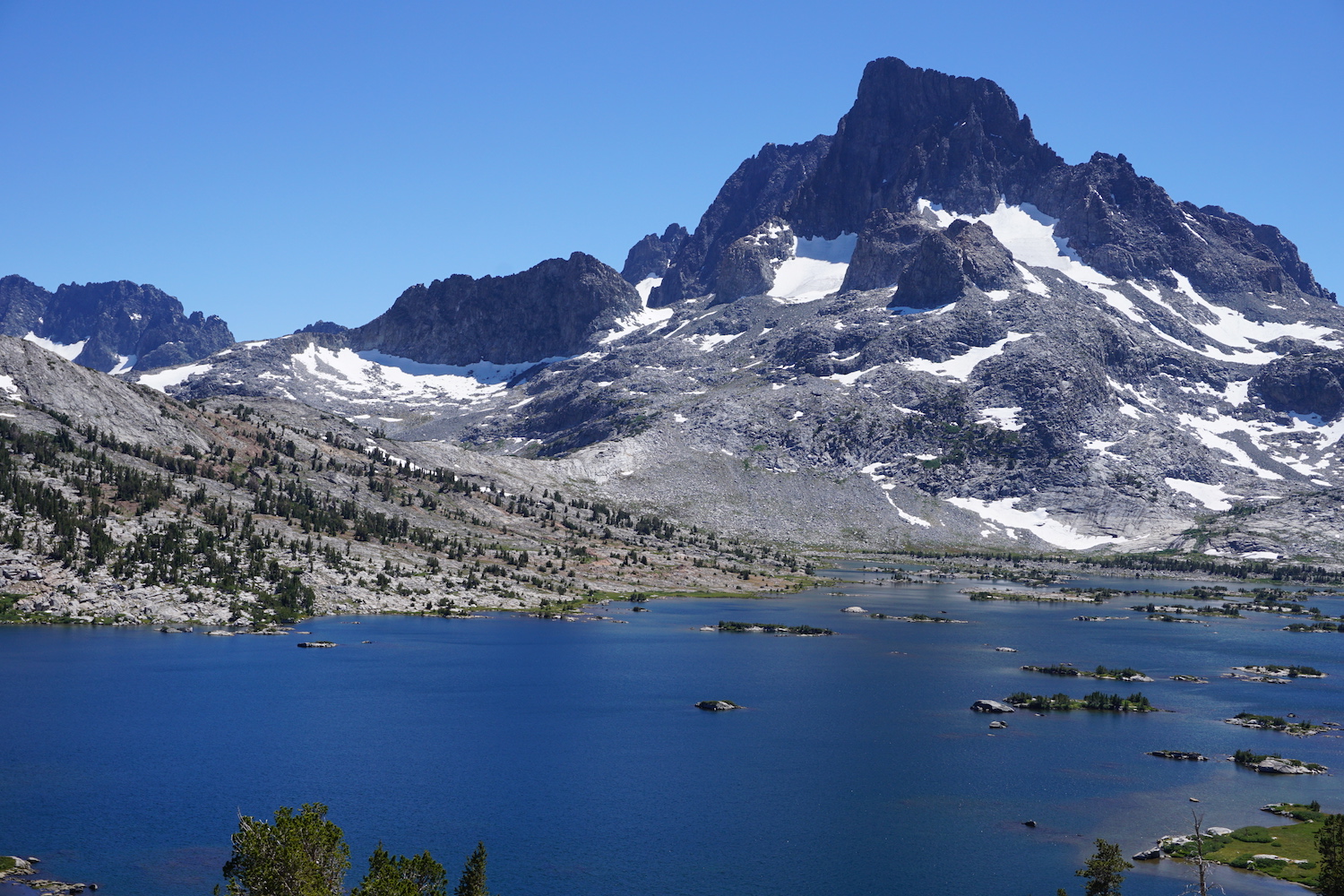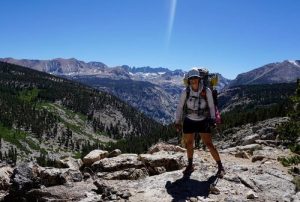Redefining Success

Redefining Success
(And Self) on the John Muir Trail
By Mandy Schenkemeyer
“What am I doing out here? I don’t want to be here.” It was only my third night on the John Muir Trail and utter soul-wrenching shake-you-to-the-core loneliness had set in.
—
 I identify as a stubborn perfectionist. I fill my life with daily reminders to take it easy on myself: a bracelet I wear each day says, “you are enough,” a magnet on my fridge tells me, “life doesn’t have to be perfect to be wonderful,” another reminder of “you are enough” rests on the bathroom mirror. Still, I often beat myself up over what I see as failure. When I set out to hike the 220-mile John Muir Trail solo, not completing the entire trail wasn’t an option. It hadn’t even crossed my mind. I’m an outdoor educator and thought I was in for a vacation.
I identify as a stubborn perfectionist. I fill my life with daily reminders to take it easy on myself: a bracelet I wear each day says, “you are enough,” a magnet on my fridge tells me, “life doesn’t have to be perfect to be wonderful,” another reminder of “you are enough” rests on the bathroom mirror. Still, I often beat myself up over what I see as failure. When I set out to hike the 220-mile John Muir Trail solo, not completing the entire trail wasn’t an option. It hadn’t even crossed my mind. I’m an outdoor educator and thought I was in for a vacation.
I started out of Whitney Portal later than I had wanted, but with high winds, daylight made me feel safe. I spent the first several hours reflecting on the previous week spent with a college friend. After a week of incredible companionship, hiking alone presented a mental and emotional challenge, but at the time, I felt up for it. Aside from the wind blowing me over a few times, I handled the 42 pounds on my back well and felt up for the physical challenge, too.
The John Muir Trail runs 211 miles from the summit of Mount Whitney to Yosemite Valley. Most would say the trail is 220 miles because you can’t magically transport yourself to the top of a mountain. You must slog the 10-plus miles to the summit of the tallest peak in the lower-48. Initially, I planned to go all the way to the summit of Mount Whitney, even though my friend and I summited four days prior as a long day hike. When I considered the high winds and the many miles that waited for me on the other side of Whitney that day, I asked myself “Why?” This was the first time I asked myself that. I realized I didn’t even know why I was on the trail. Other people asked, and I often responded with, “Why not?” I knew why I loved Type 2 fun — I love overcoming physical and mental challenges. They teach me self-efficacy. They remind me that I am strong and capable. But why this trail, why now, why alone? As far as I could tell, I was just out there to crush. Fortunately, the mountains had something else in store for me.
My question about purpose led to a deeper one: “What am I trying to prove and to whom?”

On Mount Whitney
It rolled around in my mind while I hiked up 6,100 feet and 99 switchbacks. I realized that all this time, I had been trying to prove my worth to myself. And sure, in some way, I also wanted to prove my worth to a few bad apples that treated me like I had none. My “go big or go home” philosophy tried to fill a void of self-worth. My self-worth was not at the top of some peak or pass, fitted neatly into a little box, wrapped in a bow, waiting for me to pick it up.
My self-worth was not at the top of some peak or pass, fitted neatly into a little box, wrapped in a bow, waiting for me to pick it up.
On top of that, seeing my friend bag his first 14er brought more joy than any solo summit could. I found myself exploring this. What was I doing out there alone? Solo is going bigger isn’t it? I toyed with these thoughts, remembered some of my favorite experiences in the outdoors, and noticed a common thread. It wasn’t always what I was doing outside, it was who I was with and the camaraderie we shared that made those experiences worthwhile. Above all, yes, even above adventure, I value connection.

I decided not to return to Whitney’s summit. This “lack of accomplishment” is one of my biggest accomplishments to date. My first day had already been a success.
But moving on, what did I do with my newfound self-awareness? Broke. Down. My emotions seemed to mirror the terrain; up and down and not at all easy. Over the next two days, I rode an emotional roller coaster. At 13,200 feet, Forester Pass was my tipping point.
 When I reached the top of the pass, I saw a few small groups of people congratulating each other on their success. And there I was. ALONE. My aloneness was so salient, I couldn’t appreciate the beauty around me. That beauty was meant to be shared with others. I had seen only two solo hikers, both male, and neither shared my slower pacing or desire for companionship. That night, completely alone in the woods, my heart ached. I wanted to tell my close friends and my family about my insights. I wanted to share the beauty of the mountains with them. I wanted to hear their voices. I wanted to hear my own say something other than “Happy trails!” I poured over my maps, devising a plan to get to more populated camping spots faster. I looked at ways off the trail. Maybe I could just give myself a few more days.
When I reached the top of the pass, I saw a few small groups of people congratulating each other on their success. And there I was. ALONE. My aloneness was so salient, I couldn’t appreciate the beauty around me. That beauty was meant to be shared with others. I had seen only two solo hikers, both male, and neither shared my slower pacing or desire for companionship. That night, completely alone in the woods, my heart ached. I wanted to tell my close friends and my family about my insights. I wanted to share the beauty of the mountains with them. I wanted to hear their voices. I wanted to hear my own say something other than “Happy trails!” I poured over my maps, devising a plan to get to more populated camping spots faster. I looked at ways off the trail. Maybe I could just give myself a few more days.
My choice to leave the trail snuck up on me. After a restless night, I packed up and hiked 7.5 miles over Kearsarge Pass to a popular trailhead where I could hitch a ride into town. On the way, my heart lightened. The tears stopped. I noticed the beauty around me. I appreciated these signs; I knew I had made the right decision.
After reaching a motel in a nearby town, I called my mom and a few close friends. After some initial confusion, they each said they were proud of me. They knew quitting was perhaps the hardest decision of all and while I may not have known why I was out there initially, I clearly had already found what I was looking for: my truest self.
I drove south to spend time with another friend and fulfill my need for meaningful connection. I found myself back on the trail several days later with a clearer mind. This time I knew why I was there. I was making no attempt to finish; I wanted to see what other bright ideas my mind and soul might have when nature’s solitude strips them down to what really lies within.

When I returned home, everyone wanted to hear about my trip. Although uncomfortable at first, researcher Brene Brown would say that vulnerability is essential to connection. So I began opening up about my breakdowns, my breakthroughs, and the amount of miles left unfinished. I was unexpectedly rewarded with support, praise, and best of all, love.

Mandy on the trail
I mentioned that the thought of not finishing all 220 miles hadn’t crossed my mind before I began. That version of myself would feel overwhelmed with failure. Living with the authentic self that this adventure helped me uncover, it’s the opposite. I often ask the students I work with about success: “What defines success; is it the product or the process?” It’s about time I gave myself the right answer to that question.
Sitting here today, with over half the trail left untraveled, I’m more successful than ever.
Mandy Schenkemeyer is an outdoor educator in Washington state. Find her on Instagram.
Be the first to comment